The Scythians, the biblical “people of other faiths”
But who exactly are these "people of other faiths?" In the above referenced dialog between Jesus and the Jews regarding Jesus' lineage, Jesus, refers to Psalm (of David) 110 where "David calls him his Lord," and, in turn, asks the Jews: "... then how can he be his son?" (Luke 20:41-44). But Jesus, referring to Psalm 110, also says something else: If Jesus calls himself "David's Lord" in one part of the Psalm, then the part, "You are a priest forever according to the Order of Melchizedek," also refers to Jesus. Saul-Paul, in apparent ignorance of Melchizedek's Sumerian faith, assumes that he was a Jew when he calls Jesus "high priest forever according to the Order of Melchizedek" in his letter to the Jews (Hebrews 6:20). According to these sources, then, Jesus descends from Melchizedek's kin and, as we shall see, so does his mother. So let us research Melchizedek's clan.
"And Melchizedek king of Salem brought forth bread and wine: and he was the priest of the most high God" (Genesis 14:18).
Saul-Paul's letter, referenced above, calls Melchizedek king of Salem:
"This Melchizedek was king of Salem and priest of God Most High" (Hebrews 7:1).
The place of which Melchizedek was king, however, is ill-defined. Jewish commentators claim that Salem is Jerusalem. But (earlier) archaeological evidence says otherwise. Jerome maintains that the Salem of Melchizedek is not Jerusalem, but a town near Scythopolis, and identifies it with the place where John baptized. In fact, the ruins of the Palace of Melchizedek were (then) still visible, and the site was a pilgrim destination. Such physical evidence undercuts any speculation to the contrary. Since it is highly unlikely that a community some eight Roman miles from a city the size of Scythopolis would have its own king with a stature worthy of so much reference, the reasonable conclusion is that Melchizedek was a king who reigned over his people from his palace in the suburbs of Scythopolis.
Here, we are already among Scythian kindred, that is, in the region of Scythopolis, about twenty-six miles from Bethlehem, Galilee. It is here that Melchizedek, "the high priest of God," once lived and functioned; and just as Jesus did later, gave bread and wine to his faithful in accordance with his own religious rites. Further, according to Greek Mythology, Bar-Kus was raised by nymphs here, in Scythopolis, and it is here that he planted the famous vineyards. This mythological account brings Scythopolis even closer to the Scythian people because Bar-Kus is Nib-Ur's (Nimrod) name in Greek, and the Scythians considered Nib-Ur (Nimrod) their patriarch.
A high level of mental discipline is needed not to be fooled by various biblical writings referencing the Order of Melchizedek. They explicitly emphasize that "he was not a Jew," but a king of a "people who had their own religion." Their teachers, the magi of the Order of Melchizedek lead the Scythians toward the Holy Trinity of Light according to the Scythians' belief. This is why Bit-Lah-Mi (Bethlehem) had received its name, "Home of the Virgin of Light" much earlier. Scythian teaching foretells the birth of the human Mother of God's Son coming to Earth, here, in this town. And that is precisely what happens thousands of years later.
When Badiny mentions these prophecies, he is first of all referring to the many cuneiform-written predictions from the Sumerian city, Mari, which mention "a divine visit appearing in human form." The Uruk Oracle (2000 BC) speaks similarly. It mentions the visit by the Mother Goddess. Similar prophecies written during the middle of the second millennium BC were found in Ugarit, Palestine. In the study of Jesus' teaching, he underlines and emphasizes a very important fact: Melchizedek's name in the cuneiform records originating from the Kassita-kusita era, is written in the same language as the names Bit-Sa-An, Scythopolis, "House of Heaven faces" and Bit-Lah-Mi, Bethlehem, "House of the Virgin of Light." In this language, Melchizedek appears as Milki-Ilu meaning the "God of Truth." Since this is the name by which Jesus called the Father who sent him to Earth, Badiny ponders the likelihood of Jesus referring to the Scythian king, Milki-Ilu as his biological ancestor (Some believe Milki-Ilu was one of several earlier incarnation of En-Lil [Jesus])—others being Nib-Ur and Gudea.
Among the other non-Semitic peoples of Galilee in Mary's and Jesus' time are the descendants of Sumerians whom the "Great Assyrian King" resettled in Galilee and Samaria from Babylon, Kut, Hamath, and Sepharvaim in place of the deported Hebrews:
"Then the king of Assyria brought people from Babylon, Cuthah, Ava, Hamath, and from Sepharvaim, and placed them in the cities of Samaria instead of the children of Israel; and they took possession of Samaria and dwelt in its cities" (2 Kings 17:24).
And, here, the well-known orientalist and scholar (e.g., archeology, linguistics) W.F. Albright, provides for us a very important piece of evidence regarding the identity of these people: He identifies Sepharvaim as Sippar, whence, according to Werner Keller, the Parthian magi came to Jesus' cradle. These people have kept their old faith, the magi's reverence of Light, as recited in the prayers of several Christian religions: "According to the Order of Melchizedek."
Considering the above, it is safe to say that Scythopolis was the city of the people of Galilee and Samaria the Greeks called Scythians, and that Milki-Ilu (Melchizedek) was their king. So let us research these so-called “Scythians.” Oppressed intellectuals behind the Iron Curtain used to whisper among themselves, “the past is unpredictable,” in reference to artful historical propaganda, a perpetual campaign of deceit, financed (mostly) by the American Jewry and implemented by the progeny of the Russian Jewish Blank family, Vladimir Lenin, to control the masses. In our research, we run across contemporary educational material in which we recognize the same “artwork” as recurring patterns in the web of deceit the Jewry has been spinning for 45 centuries. One of its trademarks is misrepresentation of peoples, a fraud exemplified by the West's definition of the Scythians—the Greeks' name for Magyar (biblical Magog), Hun peoples—variably referred to as Huns, Iranians, Turanians and Asians. Western literature typically defines them as nomadic warrior tribes of uncertain origin who wandered on the steppes of Asia on horseback in the 7-3rd century BC and traded their grain with the Greeks for gold until they disappeared from history after being conquered by the Sarmatians. So let us look at a few of these descriptors, starting with the Scythians' origin.
According to the Isfahan Codex, the Huns trace their origin back 28,000 years (Detre, 2004, 2005), while Grover S. Krantz, anthropologist at Washington State University, writes that the distribution of the Magyar language allows only one explanation, namely, that this language family, already established in Hungary by the Early Neolithic” (c.10,000 BC), spreads east (as the ice retreats). Therefore, the language of the people who live in, and east of the Carpathian Basin, according to Krantz, is Magyar, “the oldest in-place language of all of Europe,” as he puts it. Krantz' claim is supported by—among others—a stick fragment found in the 15-20,000 year old layer of the Carpathian Basin (Jankovich Cave, Bajót, Hungary) which clearly shows carved symbols recognized as Hungarian runic script (Freidrich, Klára, Selected Studies in Hungarian History, 2008, p.303). Examination of racial and cultural markers—other than language—of the early inhabitants of central Eurasia also points to a homogeneous people by exclusion: Anthropological and archaeological evidence shows an unbroken, substantially uniform race and culture dating back to at least the Linear Band Ceramics culture (5700 BC), centered in the Carpathian Basin (T. Douglas Price et al., 2001). Thousands of years later, the 3rd century BC Babylonian historian, Berossos, links the Magyars' mythological patriarch, Nib-Ur (Nimrod) to the Scythians. Later still, emissaries arriving at the king's court in the Carpathian Basin for the 1554 Székey National Conclave still call the Hungarians “Hun-Scythians.” According to these sources—and others—the homogeneous indigenous peoples of central Eurasia have an unbroken past dating back to at least the Early Neolithic; are called Huns, Hun-Scythians and Hungarians; and speak and write the Magyar language.
Marton, Veronica gives us a fairly accurate picture of the Scythians' origin and location, with concentration on the Near East (The History of the Chaldean-Sumerian People: Selected Studies in Hungarian History, 2008, p. 575-576). The following is a verbatim quotation from her work, including her sources [in square brackets]:
“1. The Old Stone Age (c. between 1.200.00-8000 B.C.) [Vértes, László: Kavics Ösvény and Gáborné, Csánk Vera: Az ősember Magyarországon, Gondolat, Budapest, 1980]
In 1965, in Vértesszőlős, in Hungary, archeologists found the skull-bone and remains of an erect tool-making ancient man (archantropus) from the later phase of the Paleolithic, together with his habitat, footprint and stone tools. According to astronomical chronology he was about 400-450 thousand years old.
One of the oldest, erect beings, who can be called human, is this so-called Vértesszőlős man who lived during the later phase of the Paleolithic (c. 1,200,000-200,000), who migrated from the Carpathian Basin, today's Hungary, to all parts of the world. According to P. V. Tobias, anthropologist, the paleanthropus is a direct descendant of the Vértesszőlős man and his descendant, the Homo sapeins.
'The vast majority of the Paleolithic man had a refined stature and belonged to an anthropologically already specialized race... Around the end of this epoch... different ... racial types, ethnic types began to evolve—the forerunners of today's races and ethnic types.'
The era of the Ancient Man lasted 30,000 years from early 80,000 B.C. 'During the last interglacial, warm period, a series of new cultures matured. They lay hidden and then, all of a sudden come to full bloom, as in a green-house... In biological development we know of such hidden states, which are followed by the 'revolutionary' cycle of evolution. Genotypes that have not changed for a long period of generations, almost in an explosive manner, bring forth new genotypes within a few generations... The evolution branched off quickly and unexpectedly.' This is the culture that is called Neanderthal type or, after its French archeological site, Moustierian, although it should be named after Vértesszőlős.
'The last warm period before the last glaciation—the beginning of the mid-Paleolithic—is the age of the real ancient man. Around 70,000 they were already ... intelligent human beings, on par with us and they wondered as hunters in Europe and the Near East. Their outer appearance still differed from today's people, but their life-style and culture were much more advanced than we may think... They used stone tools which appear simple ... and hunted.'
Following the lead of the Hungarian archeologists, Miklós Gábori, Mrs. Vera Gábori Csánk, Dr. Gyula László and also the American anthropologist Grover S. Krantz, one can state with confidence that the eastern connection with the Carpathian Basin already existed in the Paleolithic!
2. Intermediary Paleolithic (c. 8000-5500 B.C.) [From the works of Colin Renfrew—Paul Bahn: Régészet, Bp. 1999., Osiris]
In the Near East, between 8000-5500 B.C., in the intermediary Paleolithic, the ancient man of the Near East had already given up his hunting, gathering, fishing life-style and had changed to a hunting-nomadic life. The change of life-style resulted in domesticating and catching such animals, with which he was able to cover greater distances and he was also able to settle down.
In the intermediary Paleolithic, the so called 'Neolithic Revolution' did not bring a quick change but it resulted in a long evolutionary process lasting several thousand years. The first settlements were formed. The earlier hunters worked on the land, domesticated animals, grew cereal plants and started a primitive form of commerce. Their settlements were unearthed in three archeological sites, in Jarmo, Jerico and Catal Hülyük. [Professional literature is not uniform concerning the age of the above settlements. Jermo can be connected with the earliest agriculture and animal husbandry and still they believe Jerico to be the oldest. In every chronology (if it is mentioned at all) Jarmo is mentioned in the first place, Jerico follows and finally Catal Hülyük. (MV)]
The first settlement—Jarmo—of the so called Pre-ceramic Age was excavated south of Kirkuk (Western Iraq). 'Here not only the domesticated cereal plants (spelt, barley, peas and lentils) were found but they were also able to identify their transitional forms.' This is the earliest settlement where the inhabitants practiced agriculture.
Jerico is the territory of today's Israel but, in Paleolithic and Neolithic times, there were no traces of Semitic or, to be more precise, Jewish populations. Archeological finds of this age are the products of the Vértesszőlős (Neanderthal)-type man. Their direct descendants were the human groups of the Scythian race. (Semites appeared here only at the turn of 3,000-2,000 B.C., but by the centuries after Christ, they completely replaced the Scythian indigenous population.)”
Marton then traces the Scythians in 14 stages from the Neolithic and early Copper Age to the Persian conquest of Babylon in 539 BC. (An outline of the history of the Scythians in the Near East from the Flood to Mary's birth was covered under Historical overview, above).
Next, let us look at the “nomadic warrior tribes” descriptors. The West likes to use the trendy terms, “nomadic” and “tribe“ to describe peoples it would like to hide but cannot. But it often gets tangled up in its own web. Its “historians” define the Scythians as nomads, but then contradict themselves by claiming that the Scythian “tribes” traded grain with the Greeks for gold. They seem to forget that grain production depends on farming, an activity that precludes any sort of nomadic lifestyle. (The Kőrös Culture, a settled farming society, is already established in the Carpathian Basin by the 7th millennium BC.) A more likely explanation for the movement of people is transportation (their wheeled wagons have been found in 3rd millennium BC strata) of raw materials and civilian and military goods and supplies; control and administration of their vast land; and seasonal activities related to livestock husbandry and farming. There are also several problems with the Scythians trading their grain with the Greeks for gold claim—though one example should suffice. Huge quantities of gold artifacts are found throughout Scythia, many of which predate the Greeks (Scythia has an abundance of gold deposits). For example, an arm from the throne of a 7th century BC Scythian king is evidence of (by then) an advanced civilization that flourishes during a time when the Greeks do not even (yet) exist (as a people).
The “warrior” adjective is probably appropriate, but only to a degree. Considering the dispersion of their population over a wide area, protection of crops, livestock, farms and transportation routes, both domestic and to the Far East, depends on security provided by an effective military presence, garrisoned at key points. And “tribes,” of course, is but a subtle way to say “primitive.”
The “conquered by Sarmatians” claim is perhaps the most absurd. If we examine the race, ethnicity, traditions, customs, language, the place and time of the Scythians and the Sarmatians, as described by Herodotus (and others, e.g., Indians, Chinese), it is self-evident that the two names refer to the same people. Since a people cannot conquer itself, this claim is pure nonsense. Since all of these findings (and more) have been available to scholars for some time, the logical conclusion is that the history of the Scythians in today's Western educational material is deliberately falsified.
Other researchers, however, paint a different picture. They show the Scythians, centered in the Carpathian Basin, as a highly advanced civilization with a mature written language, laws and beliefs established over many thousands of years. Led by their magi, they enjoy a high standard of living assured by an effective confederacy that promotes agriculture, industry, the arts and sciences, and protects person and property with a well-organized, trained and equipped military. These magi (singular magus, from Hungarian mag, seed, high, derived from itself, sublime), wise men and women, scientists, astronomers, doctors, pharmacists, philosophers and teachers all in one, teach the secrets of Nature, health and life, and predict cosmic events from their astronomical observations (The magi are often referred to as culture-heroes such as the legendary Celtic King Arthur and the Maya Hun-Hun-apu (Hunaphu) father of Hun-Chowen, the patron of artisans, and Hun-Batz, patron of writing [apu, is father in Hungarian]). Their scientific world-view was far superior to today's. They not only knew a more complete system of natural laws than we know today, but the first principles, too: physics, biology, and what we today call psychology. We know from John Dayton that all known metal Ages originate in the hub of the Scythian civilization, the Carpathian Basin (Metals, Minerals, Glazing and Man, London, 1978). For example, the Bronze Age is already well established in the Carpathian Basin by the end of the 6th millennium BC, as evidenced by a 5000 BC bronze adze, inscribed in Hun runic script, found in Torontal county. Three thousand years before the Bronze Age reaches Western Europe, the Scythians are already producing gold and bronze artifacts, treasures rivaled only (later) by Egypt in number, quality and artistic value (see below) (The panther-head throne arm and other gold artifacts depicting a panther are especially noteworthy because the Archmagus Gabriel calls the star “...arriving from beyond the world on the day of his [Jesus'] birth” the Panther Star, which “will also arrive to augment the light of the earthly planets, lighting up the heavens to a level never before seen and thereby signaling the arrival of the Son of God on Earth.” Further, Nib-Ur [Nimrod] literally means “Panther-Lord”).

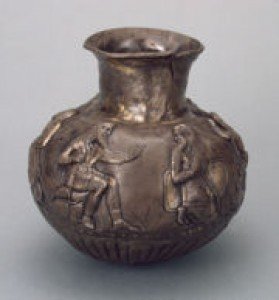

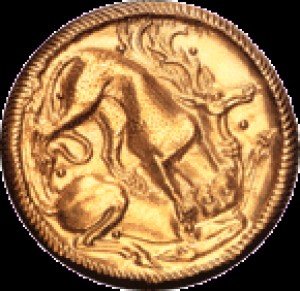
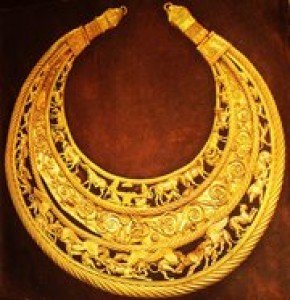
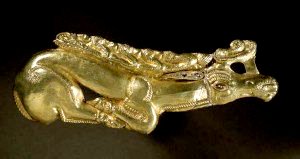
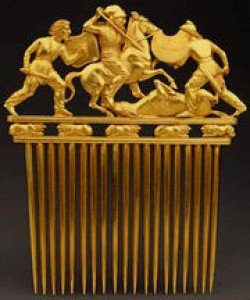
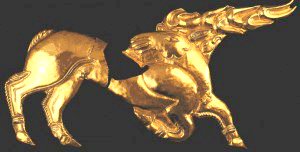
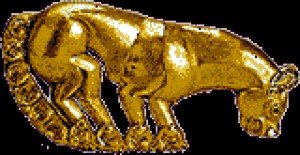
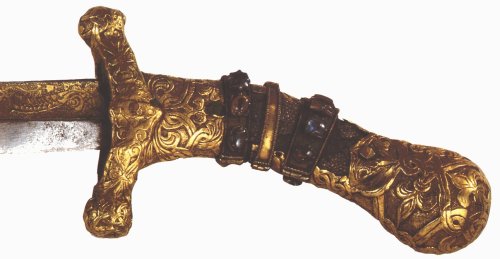
The Scythians maintain civil and military control over an area that spans continents, as well as historic cultural, trade and diplomatic ties with India and China. Like all societies, they, too, have their share of internal civil disturbances, disputes, criminal activity and problems with illegal squatters and aggressive outsiders. Nevertheless, they maintain internal order, and peace with their neighbors to whom they introduce such beliefs as an invisible benevolent Creator divinity symbolized by the sun, and the concept of the Holy Crown “who” unites people sharing a common culture into nations (Hungarians consider their Holy Crown a person, the supreme sovereign to whom kings swear oaths of allegiance). Grandpierre says, the Scythians are known in 2nd millennium BC India (citing the Puranic Encyclopedia, 1989, p. 667) as the Maghadi people of Saga and their Magi as Maga, while their language is called Maghori. The Scythian magi establish the first monarchy in China, the Xia Dynasty, named after the Xia Hun nation whose king, Huang Di, founds the Chinese civilization in the 3rd millennium BC. V. H. Mair, Professor of Chinese Language and Literature proves that the “Chinese” word for scholar of natural sciences, and philosopher magus, is of Central-Asian origin; and Harper (1995) says the teachings of the magi were important, primarily in the [Chinese] royal religion. The Scythians already build their churches and write their prayers on clay amulets in the 6th millennium BC (Tatárlaka), and construct the “Scythian Stone Circles,” similar to Stonehenge, in 4800 BC – 500 AD. 4th millennium BC amulets found in Egyptian graves attest to the presence of Scythian (Chaldean) magi during the creation of Egypt's culture; and Scythians found the first civilizations in Mesopotamia where they also introduce writing (Jemdet Nasr [name of excavation site, Iraq] people) around 3000 BC and, in the Americas, the agriculture-based Maya civilization, founded on the worship of an invisible Creator “God with three faces,” Kinich Ahau (also called Iz-tam-Na), symbolized by the sun. When the future Greeks try to unite city-states into a new Greek nation (6-4th century BC), they invite the magi to teach the first Classical Greek thinkers, Pythagoras, Socrates, Plato and Aristotle. “Plato often remembered that he and Pythagoras learned the best and most noble teachings from the Magi” (Clement of Alexandria). Diogenes Laertius writes that the magi educated Aristotle, and taught him that “...the stars are on fire; that a lunar eclipse is the Earth's shadow; that the soul survives death; that the rain is caused by changes in the atmosphere...” and much more.
Unfortunately, most of the Scythians' records within reach of the Holy Roman Empire and its successors have been destroyed during the cultural genocide that began in the 10th century. The number of Scythian texts burned to ashes cannot even be estimated. The edict of 1047 (Hungary) bans—under penalty of “loss of head and property”—the “Ancient Scythian Religion” and “Pagan writing.” The cultural genocide includes the burning down of entire libraries, book repositories and family collections. During the Inquisition, tracking down and burning runic-written text—along with their safe-keepers, the magi and the Táltos—is the prime function of the bishops assigned to Hungary by the Holy See (“Táltos” is often [mis]translated as Shaman). The Austrian government commissions its agent, Stromler—who changes his name to Thallódzi when he is appointed to a leading position in the Hungarian Academy of Science—to seek out and destroy ancient Magyar cultural treasures (Magyar, Adorján). Leopold (Habsburg, 17th century) orders all of Hungary's 150 forts filled with historical records destroyed. When the German lawyer, Hunsdorfer (hungarianized name, Hunfalvy) is installed as chief librarian of the Hungarian Academy of Science, he has Szentkatolnai Bálint Gábor's (a talented Hungarian scholar who spoke more than 30 languages, [1844-1913]) entire collection of runic-written scriptures burned to ashes.
Save a period of sanity during the reign of (Hungarian) King Mátyás Hunyadi (15th century), the systematic destruction of the so-called “pagan culture” ordered by the Holy See goes on for a thousand years, not only in Hungary but throughout Europe. Runic-written correspondence between Prince Ferenc Rákóczi II and the Spanish Court disappears without trace from the Court's library (Fehér, Walter Anna), as are the “book written in Scythian letters” from the Library of the Duke of Florence, referenced by István Számosközi in 1592, and verified in 1595 by the Italian geographer, Antonius Maginus. János Kájoni's study notes, dated 1673, dealing with “Hun-Magyar Runic Script” (Frederich, Klára) also disappear without trace. Even the magi's teachings of the sciences were attacked and banned during the West's Age of Ignorance—in which we still live today. Ignorant of the principles of agriculture, sanitation and hygiene, and the laws of Nature, Western Europeans could only watch helplessly as entire populations were wiped out when crops failed or diseases reached epidemic proportions (The English word magic [French, magie] derives from the magi's knowledge of the principles of health and agriculture, and of the laws of Nature they relied on to heal disease, improve crop yields, calculate and predict droughts, etc., abilities Western-Europeans did not understand). While no one knows how many millions of wood sticks and pages of paper written by the Scythian-Hun-Magyar-Hungarians have been destroyed, the above examples give us an idea of the scale of destruction. Yet, despite such efforts to rout their history, there is enough literature left on them to fill several university libraries (found, now-days, mostly in places beyond the reach of Western powers [e.g., the Far East]). However, the above should satisfy the needs of this study, so let us pick up their trail in 4th century BC Near East.
A wave of terror befalls the Scythians when Philip II of Macedon dies and his 20-year-old son, Alexander, becomes king. The young king inherits his father's huge armies and, enjoying his new powers, decides to go adventuring. What follows depends on who writes his history. Western historians like to call him Great, a military genius, and credit him with glorious conquests, monumental construction projects and the reorganization of the regions he conquers—undertakings that would span centuries—during his 13 year lark. Others consider him, at best, an undisciplined youth addicted to sadism—and other vices—who goes on a rampage of murderous destruction until even his battle-hardened soldiers find his passionate cruelty so repugnant, they kill him in 323 BC. Whatever his real history, the fact remains that, in just 13 years, he manages to destroy everything his father and grandfather spent their lives building, and thereby brings an end to the promise of an advanced Macedonian civilization (The Romans dismantle Macedon in 168 BC). The Scythians eventually emerge from their nightmare, form an alliance (Medes, Chaldeans and other kindred) and re-enter the stage of history in 256 BC as the Parthian Empire. (The term Parthian is a political definition, like American, whereas Scythian is a people such as Mayan. Parthian-Scythian is similar in meaning to American-Mayan.)
We begin our study of the Scythians' spirituality by looking up the Amarna texts (letters) dating from Kassita (Kusita) times (14th century BC), where we find Scythopolis as Bit-Sa-An ("House of Heaven Faces") near the ancient town of Bit-Lah-Mi ("Home of the Virgin of Light"), Bethlehem of Galilee. Therefore, it seems logical to conclude that the Scythians called themselves "People of Heaven Faces." This name gains further support in the Hungarian Chronicle, Tarihi Üngürüs: The Scythians, the twins (people) Hunor and Magor—who also consider Nib-Ur (Nimrod) their patriarch—set out from Adjem, that is, Elam. These people also refer to themselves by that name, as evidenced by the expression An-Sa-An (in cuneiform) meaning "Home of the Heaven Faces." Interestingly, another branch of the Scythians, the Szabirs, (Sumerians), who also consider themselves children of Nib-Ur (Nimrod), refer to themselves by a similar name, Sa-Pir, meaning "sun faced" people.
So far we know that the Scythians refer to themselves as people who turn their faces toward the heavens or the sun. We also know that a town near Scythopolis, Bethlehem, is formerly called the Home of the Virgin of Light, where the Virgin Mary gives birth to Jesus, the Son of Light, 1400 years after the Amarna texts (Letters) are written. So far, this place name supports the premise that Mary is the Virgin Mother Goddess incarnate, foretold in ancient coming of God prophecies of the “people of other faiths," whose mission is to conceive the Son of Light in compliance with, and fulfillment of the divine laws of nature. Since research to date could not determine Mary's birthplace, the logical inference is that Mary, Jesus' Mother, is also born here, in Bethlehem of Galilee. We can now expand our understanding of the Scythians' belief by discovering a motive to turn their faces toward the heavens or the sun. And that motive is reverence of the Light, Son of Light and Virgin of Light, a female deity they call Virgin Mother Goddess, who takes on human form to give birth to the incarnate Son of God.
This is how much we know of the Scythians' spirituality from the Bible and the writings referenced above. Other than references to Melchizedek and the destruction of "places of corruption" on "high places"—along with a repertoire of negative teachings about the "people of other faiths"—the Bible does not say much about the Scythians' belief. To find out more, we must seek sources of first-hand knowledge. And who could be better informed about the Scythians' beliefs than their own intellectuals, Jesus' closest students, his disciples? So let us first find out who they are, where do they teach, and what happened to their writings?

